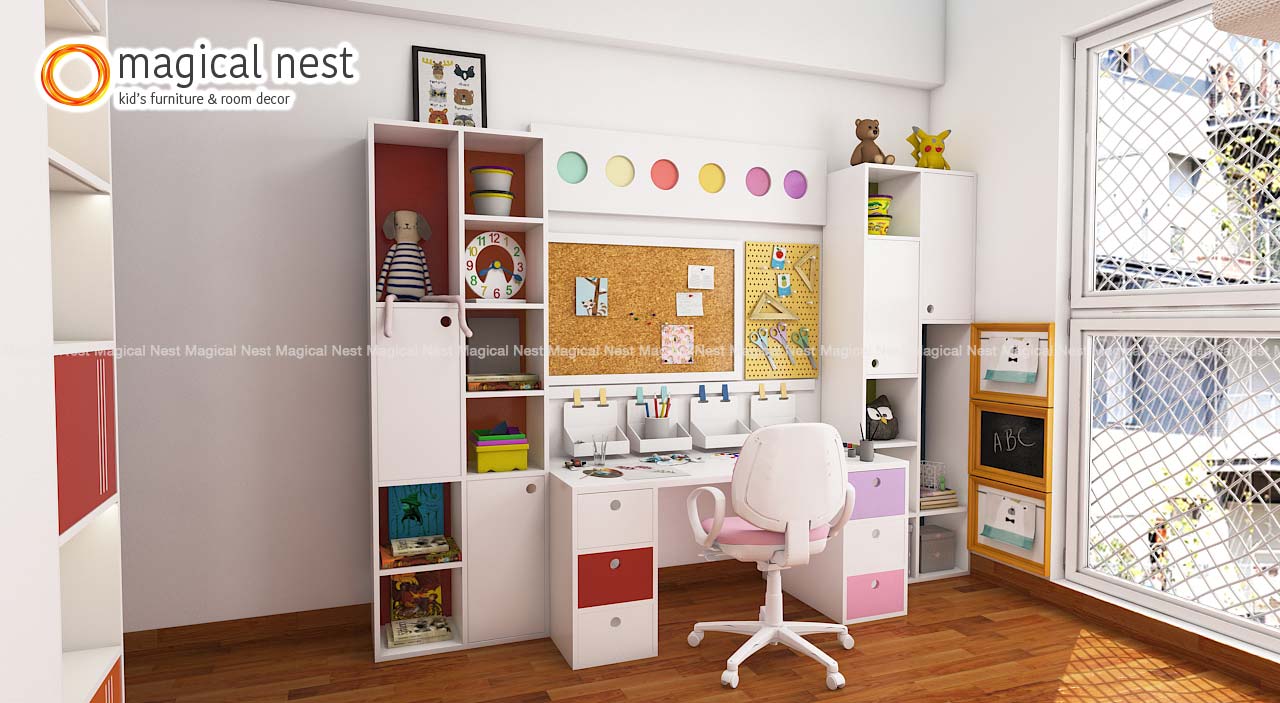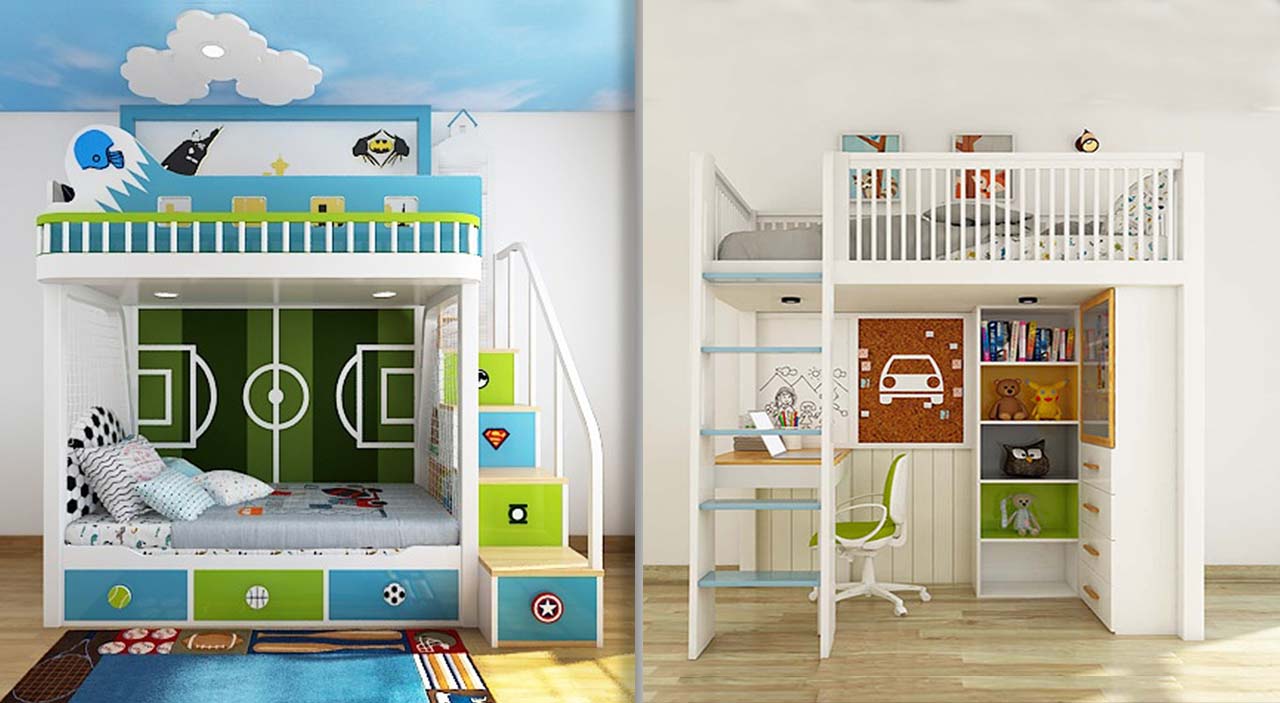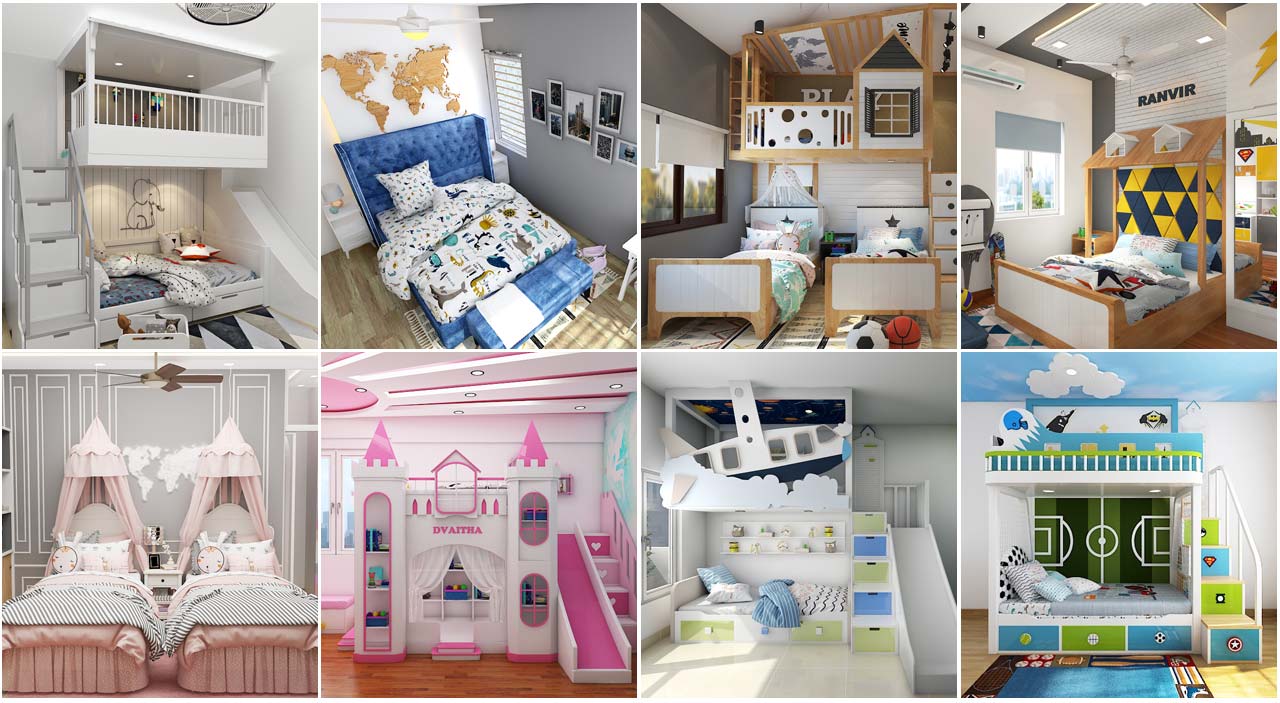
Getting your kids to study and do their homework is never an easy task. They get distracted, come up with dozens of excuses, watch the TV, and play games on mobile phones and what not! All these troubles double if they don’t have a dedicated space or room for doing their schoolwork and study. That’s where the importance of a study room or study area comes in. Whether you are living in a duplex house with multiple rooms or a two-bedroom apartment, you can easily carve out an attractive, and functional study space for your little ones.
However, there are a few things to consider while you go about designing this space, even if you are looking for a study table with a chair for kids. From choosing the right corner in the house to buying the right pieces of kids’ furniture, everything matters. Here are 9 useful tips on how to create a good study area for your children.
1. Find the right space
If you live in a big house and have an extra room to spare, consider converting it into a study room for your kids and furnish it with desks, bookshelves, study chairs, and the like. Not all families have the luxury of space, though. Parents living in small houses or apartments must first find an area in the house to be converted as the study space. It could be a corner of your kids’ bedroom, a low-traffic nook in the living room, a portion of your home office (if you have one) or other unused spaces in the house. You can even consider the space under the stairs, just like the Harry Potter closet, and your kids are going to love it for sure.
There are three basic rules you must abide by while choosing a study corner for your kid - fewer distractions, lots of natural light, and good air circulation.
2. Invest in a good study table
Now, this is the most important piece of kids’ furniture in the study area. Depending on the availability of space and your budget, you can buy kids’ study tables online or from a kids’ furniture store. Choose tables that are durable, sturdy and age-appropriate from the many designs available in the market. Your options include:
- Standard kids’ study tables: These are typically simple, clean-lined rectangular tables made of wood or other materials. Some designs might also have additional features like drawers and storage cabinets. One of the major advantages of a standard wooden study table for kids is that they are timeless and your child won’t outgrow such pieces in the blink of an eye.
- Themed desks: Want to infuse some fun into your child’s study area? Themed desks that come in cartoons, nature-inspired or other interesting themes with quirky motifs and colors will do the trick. Such kids’ desks are ideal for younger kids.
- Wall tables: Wall-mounted tables are a fantastic choice for parents who want to create a dedicated study area for kids yet don’t have the luxury of space. Also known as floating desks, they are fixed on the wall and fit conveniently in any corner of the house. And the best part - they take zero floor space!
- Study tables with storage: The greatest advantage of such kids’ study table designs is that they come with storage units to keep books, stationery, and other items. While some designs come with drawers and shelves, others have storage space beneath the foldable top.
Besides these, there are many other varieties including adjustable study desks, built-in wall study units, writing tables for kids, corner desks, roll-top desks, fold-away space saver desks, and more.
3. Pair it with the right study chair
You must also invest in a strong and durable study chair for kids. There is a good array of designs available in the market, ranging from classic wooden chairs, reading chairs, adjustable chairs, and revolving chairs to study chairs with arms, study chair with plank, writing pad chairs, mid-back, and low-back chairs, computer chairs, and more. If you want to add a little zing to space, look for chairs with interesting designs, motifs, and colors.
The chair you buy must support your child’s back and also, pair well with the style, material, and height of the desk. For instance, buying a regular plastic chair for a Marvel-themed study desk would be a disaster!
4. Make the most of natural lighting
Lighting is one of the most crucial aspects of kids’ study room designs as your child will be spending many hours at the desk, reading, and writing. It is recommended that you make the most of natural lighting by choosing a space that has windows near it. This makes sure that the area is filled with natural sunlight during the day, which is good for your kids’ eyes and has health benefits too. However, keep in mind not to position the desk or table directly against sunlight as it could be too bright and distracting.
5. Introduce artificial lighting wisely
When it comes to artificial lighting, you must make your choice wisely and install lights that are neither too dull nor too bright. You can opt for pendant lamps, tube lights, wall-mounted lamps, recessed lights, ceiling lights, and the like. In order to ensure optimal focus, you could also add a table lamp/desk lamp to the study area. An added advantage of table lamps is that they are available in attractive designs and will enhance the overall décor quotient of the study area.
6. Use the right color palette
There’s one factor that can make or break the look and feel of your kid’s study area - the color palette. According to color psychology, certain shades can affect children positively and lift their mood. Even if it is part of your living room or kid’s bedroom, you can redo the walls of the study nook with colors that stimulate the brain and increase focus.
Green, especially the moss or sage shades, can help kids focus more while bright colors like orange can boost the mood. If you are looking to create an energizing setting, opt for shades of red or yellow. Blue, on the other hand, is considered a soothing color and is ideal for bedrooms. However, the right shades of blue like turquoise or cerulean can stimulate productivity.
You could even think of painting the walls with chalk paint, which is a hot trend these days. It can perk up space in a quite unique way and also fulfills every child’s insatiable desire to write on walls. A writing wall where they can scribble all they want without getting scolded - what could be better than that?
7. Personalize with accessories
Accessories, if added the right way, can make even the simplest and not-so-great study area look fantastic. That having been said, you must take extra care not to clutter the space with more accessories than required, especially if you are battling with space issues. The key is to look for functional items that also add an element of personal touch rather than random décor pieces.
Throw in a colorful rug to the floor where kids can sit and read when they get bored of homework. If the study nook is part of a larger room, you can use floor carpets to demarcate the area from the rest of the room.
Penholders, desk organizers, and a dust bin are among the must-have study area accessories and they encourage children to stay organized and clutter-free. You can also opt for other accessories like cushions, globes, clock, maps, etc. based on the availability of space.
Nothing lifts the mood of children like nature, so how about introducing an indoor plant to your little’s ones’ study nook? Devil’s Ivy, Aloe, Jade, Chinese Evergreen, Lucky Bamboo, and Peace Lilly are some of the commonly used desk plants. Cactuses, though a popular choice of indoor plants is best avoided in kids’ room designs.
8. Get creative with wall décor
Speaking of accessories and décor, walls are a great place to apply your creative and unconventional kids’ room décor ideas. Want to keep your child motivated all the time? We know just the right wall décor for you - motivational wall stickers and posters. For those who are looking to make the walls a little more functional, whiteboards and magnet boards are excellent ideas.
How about combining wall décor with storage solutions? Look for wall hanging storage bags made of fabric in attractive designs and themes. Pegboard walls are also rising in popularity as they provide adjustable shelving options. From wall-mount file holders and personalized wall calendars to corkboards where kids can display their drawings, wall décor ideas for kids’ study rooms are plenty. You just need to choose the one that best fits the space and goes well with your child’s interests.
9. Add a bookshelf to the study area
Last, but never least, bookshelves! It is often said that a child who reads grows into a person who thinks, and true that. Your child must already have a collection of books acquired over a period of time which includes their storybooks, coloring books, bedtime favorites, comic books, educational books, encyclopedias, and others. No matter how small the collection is, introduce a bookshelf into your child’s study area.
Instead of kids’ bookshelf designs that consume a lot of space, look for something small, cute, and unique. When it comes to saving space, wall bookshelves are the best bet and they also leave a lot of room for design experimentation. Invisible wall-mount bookshelves are a favorite with parents who are looking to bring in an element of playfulness to their kids’ room. Such designs display the magical power of books, quite literally!
With the right kids’ study room furniture solutions, accessories, lighting, and colors, you can make an attractive as well as functional study area out of even the smallest of spaces. Try these ideas and make a little world for your child to study, read, write, and grow!
Get started with your kid's room




















2 comments
Modi Furniture
Hello, This post is very amazing.
For further queries, you can visit the site.
Raj Gupta
We had to create a separate study area for our 6 year old daughter otherwise she wouldn’t study at all.
Leave a comment
All comments are moderated before being published.
This site is protected by hCaptcha and the hCaptcha Privacy Policy and Terms of Service apply.